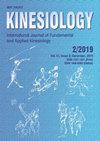五人制足球循证康复策略
IF 0.9
4区 医学
Q4 REHABILITATION
引用次数: 1
摘要
五人制足球(FT)可以定义为一项间歇性高强度活动的多次短跑运动。这可能被认为是要求最高的团队运动之一,因为英国《金融时报》选手的平均心率约为90%,工作与休息比例为1:1,活动每三秒变化一次。此外,无限制的换人次数、球场大小、较小的球和不断接近对手,这对FT球员提出了极高的要求,这是比赛的主要特点。有研究报告称,参加FT比赛会引发肌肉损伤和炎症,损伤发生率很高,因此有必要研究最有效的方法,让FT球员在练习和比赛之间快速恢复。研究重点是篮球、排球和橄榄球等其他团队运动的恢复方法,报告了被动恢复(按摩、水疗、拉伸)、主动恢复和营养技术的好处。然而,据作者所知,为FT游戏提供的恢复方法数量有限。对FT玩家来说,最有效的恢复方法只有光生物调制疗法和最佳睡眠方案。因此,当前叙述性综述的主要目的是介绍可能对FT参与者产生积极影响的恢复方法的可用科学文献。本文章由计算机程序翻译,如有差异,请以英文原文为准。
Evidence-based recovery strategies in futsal
Futsal (FT) can be defined as a multiple sprint sport with intermittent high-intensity activities. It could be considered one of the most demanding team sports due to the FT player’s heart rate mean of approximately 90%, work to rest ratio of 1:1 and activity
changes every three seconds. Besides, unlimited number of substitutions, size of the pitch, a smaller ball and constant proximity of the opponent that puts extremely high demands on FT players are the main characteristics of the game. With studies reporting that participating in a FT match provokes muscle damages and inflammations, with a high injury incidence, it is of vital necessity to examine the most efficient methods providing fast recovery of FT players between practice sessions and matches played. Research studies focused on recovery methods in other team sports such as basketball, volleyball, and rugby, among others, reported benefits of passive recovery (massage, water therapy, stretching), active recovery and nutritional techniques. However, for the best of the authors’ knowledge, a limited number of recovery methods has been provided for the game of FT. The most effective recovery methods for FT players are only found to be photobiomodulation therapy and optimal sleeping regimen. Thereby, the main aim of the current narrative review is to present available scientific literature of recovery methods that may have positive effects on FT
players.
求助全文
通过发布文献求助,成功后即可免费获取论文全文。
去求助
来源期刊

Kinesiology
REHABILITATION-SPORT SCIENCES
CiteScore
1.90
自引率
8.30%
发文量
16
审稿时长
>12 weeks
期刊介绍:
Kinesiology – International Journal of Fundamental and Applied Kinesiology (print ISSN 1331- 1441, online ISSN 1848-638X) publishes twice a year scientific papers and other written material from kinesiology (a scientific discipline which investigates art and science of human movement; in the meaning and scope close to the idiom “sport sciences”) and other adjacent human sciences focused on sport and exercise, primarily from anthropology (biological and cultural alike), medicine, sociology, psychology, natural sciences and mathematics applied to sport in its broadest sense, history, and others. Contributions of high scientific interest, including also results of theoretical analyses and their practical application in physical education, sport, physical recreation and kinesitherapy, are accepted for publication. The following sections define the scope of the journal: Sport and sports activities, Physical education, Recreation/leisure, Kinesiological anthropology, Training methods, Biology of sport and exercise, Sports medicine and physiology of sport, Biomechanics, History of sport and Book reviews with news.
 求助内容:
求助内容: 应助结果提醒方式:
应助结果提醒方式:


